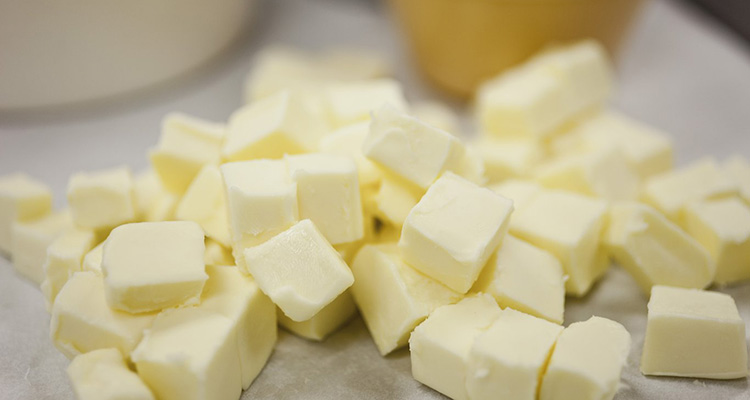
Fats are an essential ingredient in baking, directly imparting flavor and influencing tenderness and flakiness in pie and tart crusts. Most pie and tart crusts need to be made with a solid fat in order to create their characteristic tender and flaky texture. The role of fats in creating crusts is twofold: They coat the proteins in flour, preventing gluten development, which yields tenderness, and they produce flakiness by creating steam during baking, forcing apart the layers of pastry. A wide variety of fats are available for use in pastry making, each with its own advantages and shortcomings.
Butter
Butter is prized for its sweet, rich flavor and is our preferred fat for pie crust recipes, but its low melting point and overall makeup can make it difficult to work with. Unlike shortening or lard, butter is not 100% fat. It contains on average 80% butterfat, 10 to 16% water, and a small percentage of milk solids. The additional moisture in butter contributes to tough pastry dough if overworked during mixing, and the low melting point of 94°F allows the fat to melt into the flour as it is worked, changing the texture of the finished crust.
Butter is produced as salted and unsalted, or “sweet.” For baking, it is best to purchase unsalted butter, as manufacturers add varying amounts of salt, making it difficult to control the total amount.
Vegetable Shortening
Shortening is made from hydrogenated vegetable oil and is 100% fat, white in color, and flavorless. The process of hydrogenation saturates fats in the oil and changes them from liquid to solid fat at room temperature, also raising the fat’s melting point. As shortening is able to withstand higher temperatures and does not melt easily, it creates flaky and crisp yet tender pie crusts when used alone or in combination with butter.
If you are historically frustrated by shrinking or tough pie crusts, consider swapping out a portion of butter with shortening for an easier-to-manage dough.
Lard
Lard is semi-soft rendered pig fat with a consistency similar to that of vegetable shortening. Though it was once very commonly found in pie crusts and other pastries, even more so than butter, lard became less popular with the introduction of vegetable shortenings. It is relatively neutral in flavor, but adds a subtle savoriness not found in butter or shortening. It is making a comeback, as a “natural” dairy-free alternative to butter.
